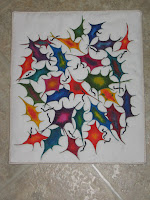FFFC Challenge #40
Dec.25 Due: Jan. 2 Hostess: Rhoda Forbes
Introduction:
I thought it would be fun to explore why certain colors are used in product packaging. Advertising is a very interesting world of color and perhaps can lead us on another color journey. The question we will answer in this exercise is the ‘why’ of certain colors, and the ‘amount’ of certain colors in product packaging. Please submit a picture of your chosen package along with your finished piece. Tell us a bit about why the colors attract the buyer and how it evokes different moods. Most of all have fun with it.
Color Scheme: Product Packaging
A cereal box is a great place to start. Or perhaps you have a favorite chocolate box, cookie box etc. For this challengewe will use the color scheme from a product package.
Nature Theme: Plants
Use any type of plants in your composition, be it alive or dried. Choose the type of plant that will fit the color scheme you have chosen, or take a ride on the wild side and choose a plant that would not be those colors at all.
Technique: Still Life
Still life can also be mood evoking, and your color scheme and how you use it will reinforce this. Does your package have a lot of one color? Would you use it for the background? Or you can try the opposite and use less of the main color of the package, does it give the same message as the original?
References:
Color Scheme:
Listed below are some websites that give information on why certain color schemes are used. It is all about selling
product. I found them all very interesting. This is a subject I had never gave much thought to until I started researching for this challenge.
How color effects us
http://www.colormatters.com/color_trademark.htmlPsychology of Color; Color Psychology and Marketing
http://www.precisionintermedia.com/color.htmlHow do colors effect our mood
http://iit.bloomu.edu/vthc/design/psychology.htmGreat article on color and placement of cereal boxes, Google your favorite cereal with color scheme following, ie;
Kellogg’s fruit loops color scheme
http://tinyurl.com/yemh3ygGeneral Requirement of colors that sell
http://tinyurl.com/yefzac4How to use coloring in packaging. There is some great reading here, how Pepsi’s Crystal packaging failed, a good
paragraph on how cereal popularity depends on color.
http://tinyurl.com/y9ez9bcWhy food companies use red.
http://tinyurl.com/ye4oyo6A very good article on the importance of color in advertising. Print is small so use the magnifier so you can read it.
http://tinyurl.com/ye35wmtTechnique: Still Life
What makes a good composition. When planning a still life this may be the first area we need to review.
This is a very good article on this subject, by Ken Gilliland
http://www.empken.com/tutorials/composition.pdfHow to balance a still life.
http://tinyurl.com/yd2donuA rather nice article on Paul Cezanne and one of his still life's.
http://maryadamart.com/cezanne_essay.htmEverything you might want to know about still life compositions. There are a lot of interesting links.
http://www.squidoo.com/still-lifeJean Louis Mireault’s Silk painting Still Life.
http://www.absolutearts.com/portfolios/m/mireault/Very Modern Textile Still Life
http://srutlandwatercolor.com/galleries/textile-still/cara_mia_dance.htmlStill Life of Textile artist Marcia Stein , many versions of a teapot and bowl, very interesting how the backgrounds
site for variations in colors.
http://www.marciastein.com/html/student_work_sla3.htmlPamela Allan, one of my favorite Textile Still Life artists. I took this course with Pamela, my first introduction to
still life. Scroll way down the page to ‘Still Life Is Boring Not’ and view a sampling of Pamela’s Still life
http://pamelart2.homestead.com/newquilts.htmlPamela’s take on Still Life. Scroll down the page to ‘I am offering a new workshop called ‘Still Life….”
She has a neat take on still life. Still life in Pamela’s world is definitely not boring.
http://pamed.homestead.com/home.htmlThis page has a series of Still Life that I did under Pamela’s tutelage.
http://www.gourdsbyrhoda.com/stillife.htmlIf you type ‘still life’ into Google and click on images you will come up with many pages.
I hope you have fun with this challenge.
Rhoda





















































